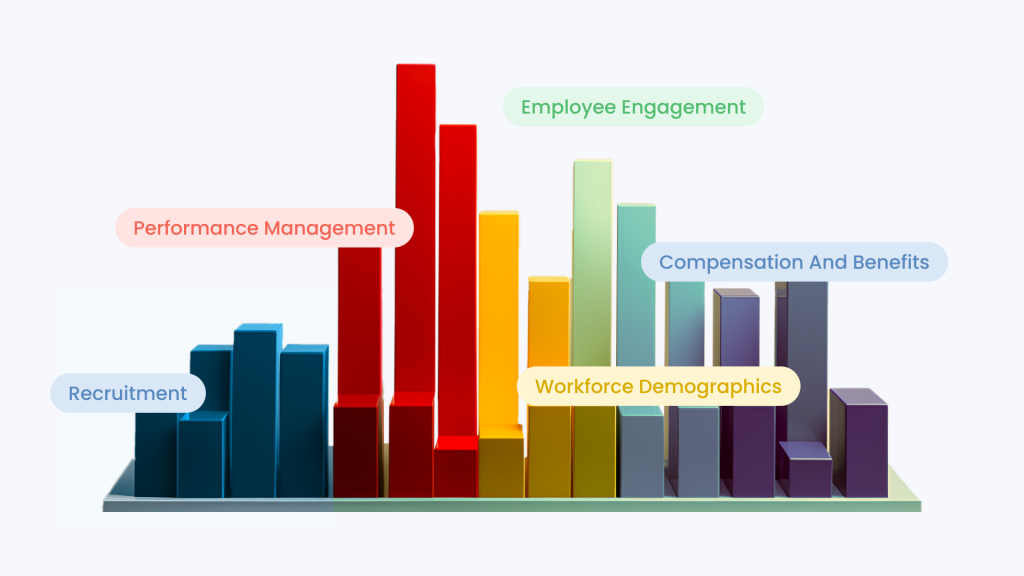You might be an HR officer in a large corporation noticing low employee morale and performance despite having adequate staff. Or, you could be in a medium-sized organization grappling with high attrition rates, finding it challenging to attract and retain top talent.
In either scenario, these challenges signal the need to adopt HR analytics while carrying out your duties. Doing so can enhance your HR practices, make informed decisions, and ultimately foster positive employer-employee relationships.
This article delves into the essential metrics for HR analytics, why it’s important for your business, and how to go about implementing it effectively.
What is HR Analytics?
HR analytics is a system of collecting, analyzing, and interpreting human capital data in an organization. Its goal is to help HR teams make better decisions that enhance business results and show the impact of human resource initiatives. It covers all employee and company data, including employee engagement, hiring, retention, skill enhancement, productivity, etc.
HR teams gather these insights from employee surveys, performance reviews, or exit interviews. You can also get them from your company’s HR software or tools for recruiting, payroll, and other HR administration.
When data is readily available, HR teams can forecast employee turnover, answer questions, and offer solutions with concrete evidence. Ultimately, you gain insights that shape your company’s HR practices and implement strategies that support organizational goals.
Why is it important for your business?
If you’re like the 60% of HR leaders from Gartner’s report, developing your team’s effectiveness should be a part of your strategy to improve the future of work in 2024. However, you need to arm yourself with adequate information to excel at this strategy. And that’s the essence of HR analytics. It’s crucial to the success of any organization as it helps to:
Drive decision making
HR analytics provides data-driven insights into various aspects of a company that drive an effective decision-making process. For instance, by analyzing recruitment and employee performance data, HR teams can identify and implement successful hiring practices during recruitment. Also, you’ll recognize high-performing employees and take more efficient steps in solving team-related problems. Generally, HR analytics offers an objective and more precise approach to workforce decisions than relying on your guts or unconscious bias.
Improve return on investment
HR analytics can significantly enhance return on investment by providing valuable insights into workforce dynamics, allowing HR professionals to make well-informed decisions that impact the organization positively.
By analyzing past recruitment data, you can identify effective recruitment channels and hire the right talent for your company. Additionally, you can assess employee engagement and measure performances to anticipate and prevent issues like employee burnout or high turnover. Ultimately, it allows you to create a more positive workplace for your employees.
Provide predictive insights and analysis
HR analytics applies HR data analysis and statistical methods to analyze data, identify patterns, and provide insights into HR and workforce activities.
For instance, HR teams can forecast an employee’s performance by examining past performance and engagement data. This helps the department identify why employees’ morale may be low and recognize top performers with the potential to succeed in critical roles.
Identify areas of inefficiencies
If you observe certain employees falling behind in their tasks, instead of just asking them about it, analyze historical performance data to understand the reasons for any performance gaps. Organize training sessions to enhance skills as necessary.
Also, if your HR processes are inefficient or time-consuming, HR analytics can pinpoint slowdowns, refine workflows, and automate routine tasks to improve and enhance efficiency.
HR analytics spots and rectifies areas of inefficiencies within the organization. It identifies trends causing turnovers and exposes potential issues that may not easily be discovered or resolved.
Enhances employer branding
By collecting and interpreting data, you’ll gain insights that will help create a more productive company culture. When employees perceive the company positively, it often results in lower turnover and attracts high-performing talent.
Consider this: According to Glassdoor, 86% of job seekers review company ratings and reviews before applying. If both current and former employees have positive opinions about your company, it will likely encourage potential talent to apply, thereby expanding your workforce.
What does HR Analytics measure?

In every company, the HR team is crucial for growth. From recruiting and developing talents to monitoring employee turnover, HR professionals constantly shape company culture and performance.
HR data analysis measures different human resource activities, and the right ones for your company depend on what your HR team aims to improve and achieve. Here are some examples of key metrics that you can consider:
Recruitment
When finding, selecting, and hiring qualified talents for a position, HR data analysis tracks metrics that help organizations weigh how effective and efficient their recruitment processes are. The goal is to optimize hiring strategies and identify opportunities to reduce cost of recruitment while boosting recruitment ROI.
Two key recruitment metrics are:
- Cost per hire: This metric measures the average cost incurred when hiring a new employee. It analyzes the efficiency of the hiring process and tracks all internal and external expenses the company incurred to fill a vacant position. This includes money spent on job ads, agency fees, background checks and screening costs, recruitment software costs, onboarding costs, wages of the recruiters who interviewed candidates, etc.
- Time to hire: This metric measures how long it takes for an organization to hire a new employee. It covers the number of days from when a candidate applies for the role to the point the candidate accepts the offer. For instance, if your company takes a long time to hire, the hiring process is slow and inefficient, possibly due to bottlenecks. However, by tracking this metric, HR teams can identify issues in the talent acquisition process and set goals for enhancing efficiency.
Performance management
HR data analysis sets and tracks key performance indicators related to employee performance by evaluating:
- Skills gap analysis: This HR data analysis weighs employees’ current skills and identifies skills they need to improve on to achieve business goals. By measuring this metric, HR teams will spot skill gaps and provide learning opportunities that support employee career growth, boost performance, and inspire job satisfaction.
- Training effectiveness: HR data analysis measures how effective training programs are in improving employee performance. For instance, HR teams measure the extent to which employees partake in and complete training, their skills before and after the training, their impact on company goals, etc. The first step when measuring training effectiveness is to set goals for training programs and KPIs. Such KPIs include employee performance scores, customer satisfaction ratings, or other relevant metrics related to your organization.
- Performance ratings: This HR analytics yardstick assesses the number of employees rated as high, average, or low performers. Its goal is to identify possible gaps in the performance evaluation process and spot areas for improvement.
Employee engagement
HR data analyzes employee engagement to help businesses understand, monitor, and boost the employee experience for better workplace culture and organizational success.
Metrics here include:
- Turnover rates: By keeping track of the percentage of employees that leave your organization during a given time period, you get to identify patterns and prevent future reoccurrences.
- Absenteeism rates: You should also note how often employees stay away from work and their reasons. This HR data analysis will help identify trends and implement strategies that can reduce absenteeism.
- Employee satisfaction survey result: This HR analytics metric shows employees’ level of satisfaction and commitment to their jobs. It measures their productivity to boost employee retention, loyalty, and performance.
Compensation and benefits
HR data also measures compensations in terms of:
- Pay equity analysis: Also known as an equal pay audit or pay parity audit, HR teams use a PEA to identify pay gaps within an organization. It helps to compare pay for employees with similar duties to notice any unfair differences. Furthermore, conducting a PEA during HR data analysis promotes fairness and transparency creating a more inclusive workplace compensation practices.
- Cost of benefits: HR data analysis also tracks employee benefit programs by calculating the costs associated with all the company’s benefits to identify expenses and their impacts on employees. This helps to manage costs effectively and align benefits expenses with organizational goals.
- Benefit utilization rates: HR analytics also lets you keep track of employees who actively use your company’s benefits. It works by dividing the number of employees in the benefits program by the number of eligible employees. With this, you can make data-driven decisions that enhance employee satisfaction through benefit programs.
Workforce demographics
HR analytics gathers employee demographic data from various sources, such as payroll systems, Human Resources Information System (HRIS), employee surveys, and other databases your company uses. The key metrics here are:
- Gender diversity: HR analytics also monitor the gender distribution of employees concerning compensation, engagement, turnover, and other KPIs. By examining this data, you can identify discrepancies and address them appropriately, ultimately promoting gender equality and inclusivity in the workplace.
- Age distribution: This metric collects data on employees’ birth dates and age categories to determine if the company covers all employable ages and promotes an age-inclusive workplace.
Read next: The Difference Between HRIS vs HRMS
Key Steps in The HR Analytics Process
Now that we’ve gotten the basics of HR data analysis established, let’s delve into what you need to implement the HR analytics process in your own organization:
1. Identify goals and objectives
The first step to achieving anything is knowing what you want to achieve. So, consider your company’s HR objectives and why you intend to use HR data analysis for better results. Is it to hire more qualified staff, boost employee engagement and retention, offer more benefits, or improve brand perception? Knowing the objective will help you direct your HR data efforts accordingly.
2. Collect relevant data
Once you’ve determined your objectives for HR data, collect qualitative and quantitative data from relevant sources. This includes your company’s HR software tools, employee surveys, payroll systems, recruitment platforms, interviews and more. The data may consist of employees’ ages, birth dates, and past performance, among others.
3. Clean and organize data for analysis
After collecting relevant data, it’s time to collate and prepare them for interpretation and analysis. So, clean and organize the data by identifying missing values, removing errors, organizing them into categories, etc. This is necessary to get accurate results.
4. Communicate findings and take action
Share the results from the HR data analysis with your team. Then, interpret them to get valuable insights and practical suggestions that can solve specific HR challenges. Take a step further by implementing the insights while considering business goals. This will improve your HR strategies and optimize decision-making.
Leveraging Data to Empower HR Leaders

HR analytics is a powerful tool that can transform the way HR professionals operate. By leveraging data, HR professionals can make informed decisions that drive organizational success. Additionally, implementing a robust HRIS can further empower HR leaders to leverage data and make informed decisions.
With all-in-one HR software like Omni, you can leverage automation and streamline your processes while gaining actionable insights for continuous improvement and team effectiveness.Through leveraging the power of automation, Omni allows HR teams and managers access to custom reports on specific metrics in the HR data analysis process and swiftly address potential issues and drive company performance.
To join the 83% of Omni customers who have unlocked new, actionable insights after using our solution, book a free demo with our team today.


